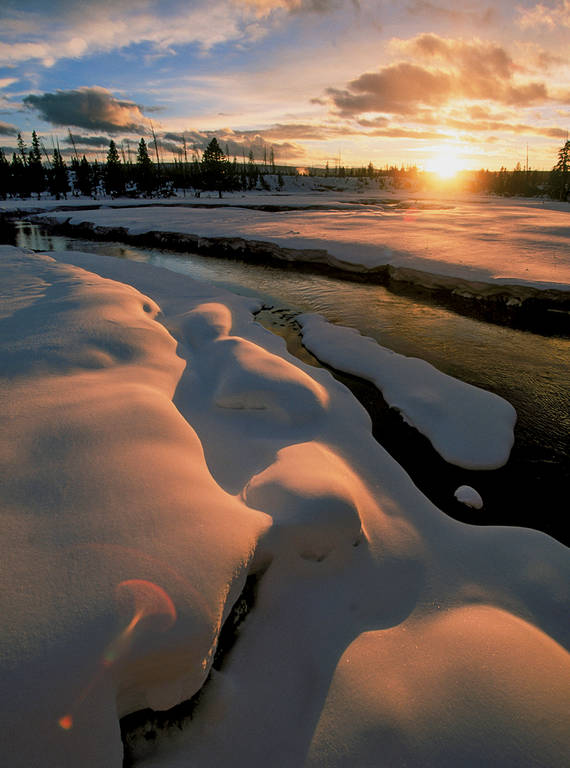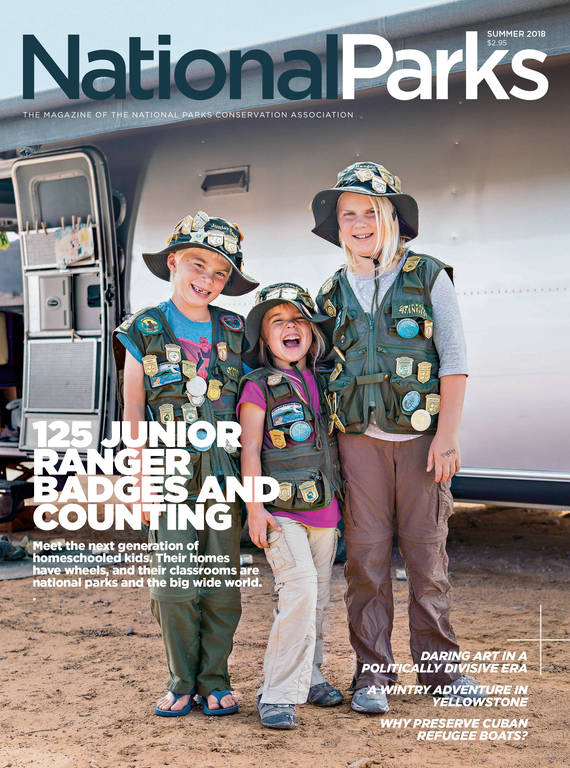Summer 2018
Snow, Steam, Bison, Sky
A winter adventure in Yellowstone National Park.
I skidded to a stop and bent over to examine the specimen. It was huge. And right in the middle of the snow-covered trail.
“Check that out,” I exclaimed as my wife, Chrissy, caught up to me. “It looks fresh.”
“There are tracks everywhere here,” Chrissy said, looking around. “They can’t be too far away.”
I turned my attention back to the giant pile of bison scat. I poked at it with my pole to see if it was frozen. It wasn’t, despite the 9-degree temperature.
“Don’t go too fast,” Chrissy cautioned. “The bison are probably right down the trail.” Her words faded under the scrape of skis on snow as I pushed off. Golden late-afternoon light spilled across the forest; trees flashed by, their shadows cutting across the trail.
As I skittered around another sharp switchback, I caught sight of something in my periphery. Jerking my head up from the trail, I watched as a massive brown creature crashed through the forest and onto the trail less than a dozen yards ahead of me. I jammed my skis sideways, but I couldn’t scrub enough speed to stop. Heart pounding, I shot into the woods. Equally startled, the bison thudded straight down the trail, snow flying in its wake. I watched transfixed, both terrified and amazed that such a huge animal could move so fast. Then I noticed a second bison running pell-mell down the trail a few yards ahead of the first. In a flash, they were out of sight.
We hadn’t anticipated getting quite that close to the park’s wildlife when we started our day at Mammoth Hot Springs Hotel, located in the northern part of Yellowstone National Park, just a few miles from Gardner, Montana. Our plan was to take a snowcoach, a modified van with oversized tires, up the Grand Loop Road to the Swan Lake Plateau. From there, we had two options: We could cross-country ski the 5-mile Sheepeater Ski Trail along the plateau, returning to the road for a snowcoach ride back to the hotel. Or we could forgo the ride and continue our adventure with a 5-mile descent down Bunsen Peak Trail and a half-mile walk back.
We debated our options on the snowcoach ride. Rachel, our driver, was concerned we might get lost (or worse) and asked us to check in at the front desk if we skied the full 11 miles back to the hotel. Sure thing, we promised, and trundled out of the van into the cold, crisp February air.
Known internationally for its abundant wildlife, geysers and other geothermal features, Yellowstone looks like a jagged square carved out of northwest Wyoming, although its northern boundary is actually in Montana and its western boundary runs through both Montana and Idaho. The 3,472-square-mile park welcomed more than 4 million visitors last year, most of whom traveled there from June through September. In winter, the number of visitors plummets.
SIDE TRIP
The lighter crowds make winter an ideal time to visit any part of Yellowstone, but the northern section of the park is an especially alluring cold-weather destination, particularly for those interested in seeing wildlife. Most of Yellowstone sits high on the Yellowstone Caldera, a mix of basins, plateaus, lakes and mountains. This wild, wind-swept country is almost entirely above 7,000 feet and experiences long, cold, snowy winters. But parts of the park’s northern reaches, anchored by the Yellowstone and Gardner Rivers, are 1,000 feet lower. The drop in elevation proves especially critical for some of the park’s wildlife, which flock north during the winter months seeking warmer temperatures and better forage.
Though wintertime access to the park is limited, visitors have a couple of options for getting around. Those who want to drive themselves are confined to the North Entrance road, the only park road that’s plowed. It stretches for a total of 45 miles along the park’s northern boundary from the Mammoth area, where the eponymous hotel and park’s administrative offices are located, to the old mining town of Cooke City, Montana, just outside the park’s northeast corner. To venture deeper into the park’s interior, travelers can book snowmobiles or snowcoaches. Both are relatively expensive and require reservations, but they go to some of the park’s famous attractions.
Our driver was headed to the groomed ski trails and warming hut at Indian Creek, but we hopped off a couple of miles before that. As the bright yellow snowcoach drove off, we shouldered our packs and pushed off into the fresh snow. I was just six weeks off a severe ankle sprain, so Chrissy broke trail as we skied from one orange trail marker to the next.

During the winter, when the number of people in the park plummets, it’s possible for visitors to go for long stretches without seeing another soul.
© JOSE AZEL/AURORA PHOTOSThe conditions were perfect, and we moved through pockets of lodgepole pine trees and wide-open meadows buried beneath an undulating carpet of white. Views spilled out in every direction. Behind us, to the south, Trilobite Point, Quadrant Mountain, Antler Peak and Dome Mountain rose above the plateau, their sharp contours pressing into the soft blue sky. Ahead, Bunsen Peak towered 1,500 feet above the flats. To our right, the steep, rocky cliffs of the Gardner River Canyon dropped to a small ribbon of green still flowing in the middle of winter.
We didn’t see anyone else on the plateau, and the sense of solitude was intoxicating. But we weren’t the only ones moving through the landscape. The fresh snow provided ample evidence of local residents. Snowshoe hare tracks zig-zagged from tree to tree. A line of coyote prints led us from meadow to meadow. Even the squirrels and mice left faint tracks in the snow.
The trail, marked by abundant blazes, proved easy to follow. One hour slipped into a second and then a third as we slowly skied our way through the miles. When we reached the trail juncture where we had to make a decision about our route, I lobbied to keep skiing: “It’s all downhill from here. I bet we’ll be back in an hour or less.”
NPCA AT WORK
Closer to two hours later, we carefully descended down the last section of trail, wary of spooking the bison again. (Rangers advise visitors to give wildlife plenty of space and to avoid startling them and making them run unnecessarily, but it’s especially important in winter when animals need to conserve precious calories to survive.) Our concern was warranted: As we inched down the final switchback, we found the pair, one of them parked on a bridge that we needed to cross, the other a few yards ahead munching grass just off the trail. Chrissy suggested that we take off our skis and boots and ford the small creek well below the bridge. I wasn’t enthusiastic about the prospect of wading barefoot through the frigid water, so we waited, hoping the bison would move enough to let us pass.
The bison was in no hurry. It took one small step and then another, ever so slightly widening the gap between us. Chrissy and I matched it, step for step, until the creature had fully crossed the bridge. With just enough space to feel comfortable, we sneaked across the span and quickly scooted off the trail, bushwhacking through some shrubs and grasses until the bison were safely behind us. We regained the trail, breathing heavily, and paused for a moment to watch the animals methodically push away snow with their massive heads as they searched for grass. We skied the final mile under the late-afternoon sun, powered by thoughts of a cold beer and warm shower.
On the morning of our second day, we packed a lunch (and our skis) and drove toward Cooke City, passing herds of elk and bison grazing along the road just east of Mammoth. When we stopped for a restroom break at the historic Tower Junction area — where Teddy Roosevelt once camped and a rustic lodge bearing his name now hosts summer visitors — a fellow motorist told us that wolves had been spotted near Slough Creek, another few miles down the road. Wolves!? We sped off, our eyes peeled for the telltale cluster of cars marking the animals’ location.
A short walk led us to the packs we hoped to find: wolf-watchers bundled in oversized parkas peering through massive scopes and cameras with giant lenses. Eerie but inspiring, the unmistakable notes of wolf howls mingled with the wild yips of coyotes hidden somewhere in the vastness. A friendly woman with a German accent let us look through her spotting scope. Roughly a thousand yards away, two wolves lay in the snow, curled next to each other. We watched awestruck as the gray one tilted her head and howled at the opaque gray sky. We counted at least four others, barely discernible in the distance.
Elk, bison and now wolves — we felt as if we’d hit the Yellowstone jackpot. But then one of the watchers told us about a trio of river otters that lived along the Lamar River, farther down the road. Ten minutes later, we found ourselves staring up an S-curve the river cut through the snow-covered valley. Sure enough, just a few moments after we arrived, a portly otter waddled down the bank and slipped into the current, joining two others already braving the icy water. In a matter of seconds, they vanished downriver.
Back in the car, we kept pushing east, with the vague notion to drive all the way to Cooke City. But soon we again found ourselves outside the car, binoculars in hand, watching a moose munch red osier dogwood branches along Soda Butte Creek. Nearby, a second moose hid behind a small clump of the rust-colored vegetation, and we marveled at how such a huge animal could effectively disappear behind the leafless shrubs.
“We haven’t seen any bighorn sheep yet,” Chrissy mused when we were back in the car, returning to Tower Junction to spend the final hours of the afternoon skiing the road up to the nearby campground and the Tower Fall overlook.
“So wolves, river otters, moose, bison and elk aren’t enough for one day?” I ribbed as we eased through our ninth or 10th knot of bison walking right up the road.
TRAVEL ESSENTIALS
A moment later, we spotted a handful of cars parked on the shoulder. Just a dozen yards up the steep slope, a group of dusky bighorn sheep with fully curled horns grazed on tufts of last season’s grass poking through the snow. We high-fived.
When we finally made it to Tower Junction, the sun began to shine through the monochrome sky. At the top of the climb we could see the 20-mile-long Grand Canyon of the Yellowstone fading into the horizon. Yellow, tan and gray cliffs, lit by the soft afternoon sunlight, spilled down to the river 1,000 feet below.
Our last day in the park dawned clear and cold. Committed to enjoying one of the more unusual park experiences, we donned bathing suits and layered on thick socks, fleece shirts, pants and down jackets. After a short drive to the trailhead parking lot, we left the warm car and walked up the frozen path. Dark gray American dippers zipped across the Gardner River, and delicate crystals of frost covered the gnarled juniper branches, grasses and pale green sage along the trail.
After 10 minutes, we reached our destination: the Boiling River, nearly obscured in swirling mists of steam. Slippery rocks lead to a spot where water from the just-this-side-of-scalding Boiling River meets water from the just-barely-in-liquid-state Gardner River. It’s one of only two geothermal sites in the park where visitors are permitted to soak or swim. We stripped off our outer layers as quickly as humanly possible and slid into the water.
It turns out there is an art to soaking in the Boiling River on a breezy 2-degree morning in February. Icy blasts of cold air swept up the valley as swells of cold water from the Gardner River flowed into the soaking pool, forcing us to sit as close to the hot cascades as we could bear while keeping everything but our faces below the water’s surface. But we soon found the right positioning and relaxed while the sun rose above the snow-draped ridges.
Our early morning start left us just enough time to ski the 1.5-mile Upper Terrace Loop Road before heading back home. In the winter, the road serves as a groomed snowshoe and cross-country ski trail that winds among the boils, pools, cascades and skeletal forests of Mammoth Hot Spring’s Upper Terrace.
Around every turn, a new feature appeared: terraced pools of steaming water, bulbous mounds of multicolored limestone capped by soft pillows of snow, cascades of mineral-rich water bubbling up from the earth. Steam clouds drifted skyward and disappeared into the cold. Two mule deer browsing in a stand of juniper trees watched as we skied past. On the final bend, the entire valley opened up before us: Far below, the Gardner River flowed green through the sage-covered foothills. Snow clung to jagged gray and brown cliffs. Electric Peak stood craggy and severe against the distant cobalt sky.
We skied the final few hundred yards in silence. The rhythmic sound of our skis on the snow slowed as we neared the trailside parking lot. When we glided to a stop, I finally broke the quiet. “That was fast,” I said, smiling. “Let’s ski it again.”
About the author
-
 Greg M. Peters Contributor
Greg M. Peters ContributorGreg M. Peters writes from Missoula, Montana, where he finds plenty of adventures just dealing with regular life. Find his work at www.gregmpeters.com.



